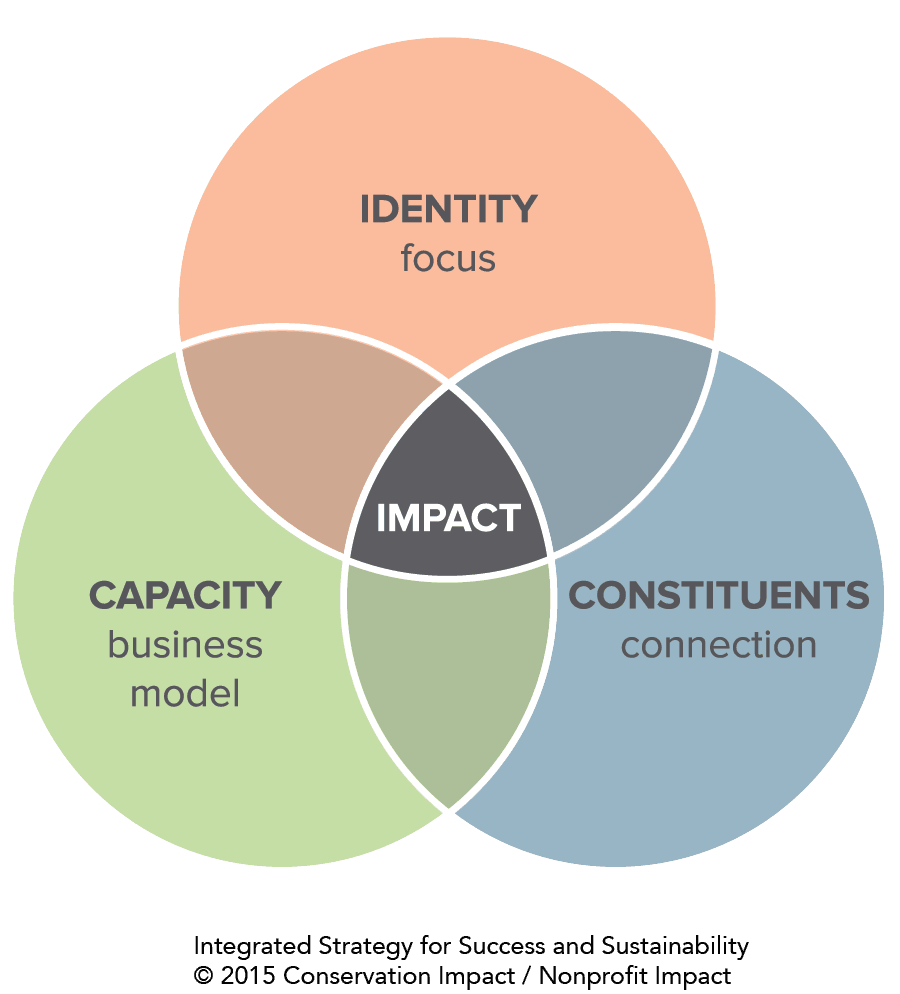
Mobilize Talent for Organizational Change
Organizations are systems. And, since systems are made up of interconnected parts, those parts must be properly aligned for an organization to adapt to change.
Our Integrated Strategy for Success and Sustainability shows how identity, constituents, and capacity align in an organizational system to create impact. As a well-aligned organization adapts to change, it first unpacks how that change affects
how identity, constituents, and capacity align in an organizational system to create impact. As a well-aligned organization adapts to change, it first unpacks how that change affects
- How it achieves mission-related results (identity)
- What its donors, community, and partners need (constituents)
- Which knowledge, skills, and abilities it must master (capacity)
Then, the organization relies on a strong applied learning function to harness that change and transform it into ever-greater results, strength, and sustainability.
Understanding Applied Learning
Applied learning is an organizational function to mobilize talent to attain mission outcomes and to support organizational development, change, and resiliency.
Applied learning is a systems approach to building knowledge, skills, and abilities into an organization’s DNA. It is a dynamic, integrated approach that incorporates learning into everyday practices and activities, across the entire organization.
Applied Learning ≠ Professional Development
Applied learning is wholly different from professional development and traditional staff training models that emphasize individual learning and performance. Putting people in a classroom for a few hours or sending them to a conference can improve an individual’s performance. However, those new knowledge, skills, and abilities are not integrated across the organization, and they often leave when the staff person does.
In contrast, applied learning not only moves from passive knowledge and skill-building focused on individuals to more active behaviors integrated across the organization, but it also embeds those behaviors into the organization.
3 Steps of Applied Learning
To embed learning throughout the organization, we have a three-step applied learning process: assess, mobilize, align.
Step 1: Assess
During the first step – assess – the organization defines the organizational outcome of the change and then rapidly determines the gap between where the organization is and where it wants to be. The key question is: How must we mobilize talent to achieve our outcome? Organizational learning objectives are developed to fill that gap and define the core knowledge, skills, and abilities necessary throughout the organization.

Step 2: Mobilize
The second step – mobilize – focuses on achieving organizational learning objectives to catalyze and solidify change. As knowledge, skills, and abilities are developed (understanding), they are translated into action. As mobilization continues, behaviors change, expectations are redefined, and even the details of how the organization does its work may shift.
For example, an organization integrating its programmatic silos mobilizes to better leverage staff talent and adopt an organization-wide approach to achieving shared goals. As a result, meeting agendas change, and actions and outcomes are correlated to updated metrics, which changes what staff report and communicate. Mobilizing may also look like cross-program problem solving or incorporating deeper connections with new audiences (customer service) into EVERYONE’s job, not just solely the responsibility of the membership staff.

Step 3: Align
The final step – align – is crucial. Alignment ensures that mobilization is ongoing and institutionalizes the knowledge, skills, and abilities developed in the organization’s DNA. Alignment includes the organization-wide supports – from leadership to volunteers, across all programs – and the tools that ensure new practices are carried out every day.
For example, does the organization collect the data, in real-time, related to organization-wide metrics so that every staff person can assess their progress regularly and adapt accordingly? Have job descriptions, performance reviews, policies and procedures been updated and newly enforced? Are there triggers, such as rewards and accolades, to reinforce new behaviors as written in the job descriptions and policies?

Applied Learning is Ongoing
Applied learning is an active, ongoing process that defines the core knowledge, skills, and abilities necessary, incorporates skill-building into everyday practice with a focus on behaviors, and embeds learning in the organization’s infrastructure. By strengthening this organizational function, your organization can harness that change and transform it into ever-greater results, strength, and sustainability.

